Hackney North (UK Parliament constituency)
Hackney North was a parliamentary constituency in "The Metropolis" (later the County of London). It returned one Member of Parliament to the House of Commons of the Parliament of the United Kingdom.
| Hackney North | |
|---|---|
| Former Borough constituency for the House of Commons | |
| 1885–1950 | |
| Number of members | one |
| Replaced by | Stoke Newington and Hackney North |
| Created from | Hackney |
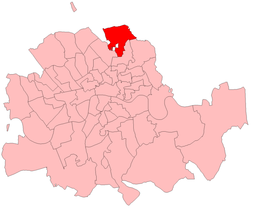
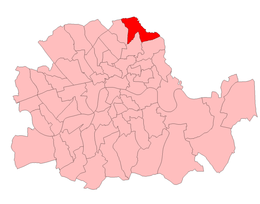
History
Elections have been held here since Simon de Montfort's Parliament in 1265 for the county constituency of Middlesex.
Under the Great Reform Act of 1832 and from then onward, Hackney formed part of the new Parliamentary Borough of Tower Hamlets. This much larger area than today's borough with that name was only divided with the creation of the two seat constituency of Hackney at the 1868 general election, comprising the large parishes of Bethnal Green and Shoreditch.[1] This was a creation of the Second Reform Act or the officially termed Representation of the People Act, 1867. Hackney's increased democratic representation provided suffrage for the first time to working-class men but was originally intended to increase the number of seats held in the House of Commons by the Conservative Party.
The constituency was created under the Redistribution of Seats Act, 1885 when the two-member Parliamentary Borough of Hackney was split into three single-member divisions. The seat, officially the Northern Division of the Parliamentary Borough of Hackney was first contested at the 1885 general election. The constituency was abolished under the Representation of the People Act, 1948 for the 1950 general election, when it was largely replaced by the new Hackney North and Stoke Newington constituency.
Boundaries
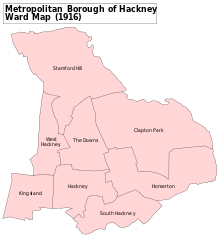
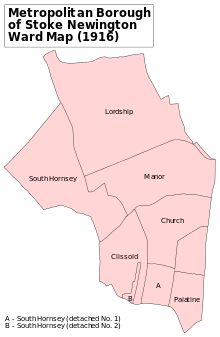
1885–1918
In 1885 the constituency was defined as consisting of:
- The Parish of Stoke Newington (previously part of the Parliamentary Borough of Finsbury)
- No. 1 or Stamford Hill Ward of Hackney Parish
- No. 2 or West Hackney Ward of Hackney Parish
- The part of No. 5 or Hackney Ward of Hackney Parish north of the centres of Evering Road, Upper Clapton Road, and Southwold Road.[2]
1918–1950
The Representation of the People Act 1918 redrew constituencies throughout Great Britain. Seats in the County of London were redefined in terms of wards of the Metropolitan Boroughs that had been created in 1900. The Metropolitan Borough of Hackney was divided into three divisions, with the same names as the constituencies created in 1885. Hackney North was defined as consisting of :
- Stamford Hill Ward
- The part of Clapton Park Ward to the north of a line drawn along the centres of Glenarm Road, Glyn Road and Redwald Road to its junction with Maclaren Street, thence across the recreation grounds in Daubeney Road to the borough boundary at a point fifty feet north of a boundary post situate at the junction of the Waterworks River with the River Lea at Lead Mill Point.
- The part of West Hackney Ward to the north and west of the centre of Shacklewell Lane.[3]
Stoke Newington was removed from the seat, and became a separate constituency.[3]
Redistribution
The constituency was abolished by the Representation of the People Act 1948. The Borough of Hackney and Stoke Newington jointly formed two seats, Stoke Newington and Hackney North and Hackney South. The bulk of Hackney North passed to the Stoke Newington and Hackney North seat.
Members of Parliament
| Election | Member | Party | |
|---|---|---|---|
| 1885 | Sir Lewis Pelly | Conservative | |
| 1892 by-election | William Robert Bousfield | Conservative | |
| 1906 | Thomas Hart-Davies | Liberal | |
| 1910 | Walter Greene | Conservative | |
| 1923 | Hobbis Harris | Liberal | |
| 1924 | Sir Austin Hudson | Conservative | |
| 1945 | Henry Edwin Goodrich | Labour | |
| 1950 | constituency abolished | ||
Elections
Elections in the 1880s
| Party | Candidate | Votes | % | ± | |
|---|---|---|---|---|---|
| Conservative | Lewis Pelly | 3,327 | 53.3 | N/A | |
| Liberal | Æneas McIntyre | 2,911 | 46.7 | N/A | |
| Majority | 416 | 6.6 | N/A | ||
| Turnout | 6,238 | 77.4 | N/A | ||
| Registered electors | 8,058 | ||||
| Conservative win (new seat) | |||||
| Party | Candidate | Votes | % | ± | |
|---|---|---|---|---|---|
| Conservative | Lewis Pelly | 3,351 | 64.5 | +11.2 | |
| Liberal | William Hickman Smith Aubrey | 1,848 | 35.5 | -11.2 | |
| Majority | 1,503 | 28.9 | +22.3 | ||
| Turnout | 5,199 | 64.5 | -12.9 | ||
| Registered electors | 8,058 | ||||
| Conservative hold | Swing | +11.2 | |||
Elections in the 1890s
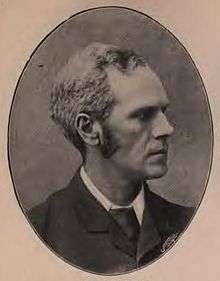
| Party | Candidate | Votes | % | ± | |
|---|---|---|---|---|---|
| Conservative | William Bousfield | 4,460 | 56.1 | -8.4 | |
| Liberal | Thomas Arrowsmith Meates | 3,491 | 43.9 | +8.4 | |
| Majority | 969 | 12.2 | -16.7 | ||
| Turnout | 7,951 | 79.0 | +14.5 | ||
| Registered electors | 10,060 | ||||
| Conservative hold | Swing | -8.4 | |||
| Party | Candidate | Votes | % | ± | |
|---|---|---|---|---|---|
| Conservative | William Bousfield | 4,799 | 59.4 | −5.1 | |
| Liberal | John M McCall | 3,280 | 40.6 | +5.1 | |
| Majority | 1,519 | 18.8 | −10.1 | ||
| Turnout | 8,079 | 80.3 | +15.8 | ||
| Registered electors | 10,060 | ||||
| Conservative hold | Swing | −5.1 | |||
| Party | Candidate | Votes | % | ± | |
|---|---|---|---|---|---|
| Conservative | William Bousfield | 4,725 | 65.8 | +6.4 | |
| Liberal | Sylvain Mayer | 2,460 | 34.2 | -6.4 | |
| Majority | 2,265 | 31.6 | +12.8 | ||
| Turnout | 7,185 | 62.8 | -17.5 | ||
| Registered electors | 11,444 | ||||
| Conservative hold | Swing | +6.4 | |||
Elections in the 1900s
| Party | Candidate | Votes | % | ± | |
|---|---|---|---|---|---|
| Conservative | William Bousfield | 5,005 | 67.3 | +1.5 | |
| Liberal | Herbert Wilberforce | 2,437 | 32.7 | −1.5 | |
| Majority | 2,568 | 34.6 | +3.0 | ||
| Turnout | 7,442 | 63.4 | +0.6 | ||
| Registered electors | 11,747 | ||||
| Conservative hold | Swing | +1.5 | |||
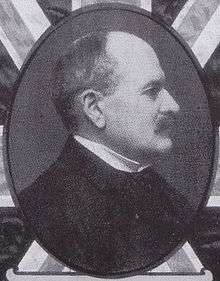
| Party | Candidate | Votes | % | ± | |
|---|---|---|---|---|---|
| Liberal | Thomas Hart-Davies | 4,655 | 51.2 | +18.5 | |
| Conservative | William Bousfield | 4,431 | 48.8 | −18.5 | |
| Majority | 224 | 2.4 | N/A | ||
| Turnout | 9,086 | 80.2 | +16.8 | ||
| Registered electors | 11,334 | ||||
| Liberal gain from Conservative | Swing | +18.5 | |||
Elections in the 1910s
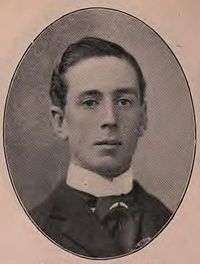
| Party | Candidate | Votes | % | ± | |
|---|---|---|---|---|---|
| Conservative | Walter Greene | 5,620 | 54.1 | +21.4 | |
| Liberal | Thomas Hart-Davies | 4,773 | 45.9 | -21.4 | |
| Majority | 847 | 8.2 | 42.8 | ||
| Turnout | 10,393 | 88.2 | +8.0 | ||
| Conservative gain from Liberal | Swing | +21.4 | |||
| Party | Candidate | Votes | % | ± | |
|---|---|---|---|---|---|
| Conservative | Walter Greene | 5,290 | 56.2 | +2.1 | |
| Liberal | William Arthur Addinsell | 4,126 | 43.8 | -2.1 | |
| Majority | 1,164 | 12.4 | +4.2 | ||
| Turnout | 9,416 | 79.9 | -8.3 | ||
| Conservative hold | Swing | +2.1 | |||
| Party | Candidate | Votes | % | ± | |
|---|---|---|---|---|---|
| C | Unionist | Walter Greene | 9,873 | 70.6 | +14.4 |
| Liberal | Wright Burrows | 4,119 | 29.4 | −14.4 | |
| Majority | 5,754 | 41.2 | +28.8 | ||
| Turnout | 13,992 | 50.2 | −29.7 | ||
| Registered electors | 27,871 | ||||
| Unionist hold | Swing | +14.4 | |||
| C indicates candidate endorsed by the coalition government. | |||||
Elections in the 1920s
| Party | Candidate | Votes | % | ± | |
|---|---|---|---|---|---|
| Unionist | Walter Greene | 13,002 | 60.8 | −9.8 | |
| Liberal | Philip Guedalla | 8,387 | 39.2 | +9.8 | |
| Majority | 4,615 | 21.6 | −19.6 | ||
| Turnout | 21,389 | 63.5 | +13.3 | ||
| Registered electors | 33,706 | ||||
| Unionist hold | Swing | −9.8 | |||
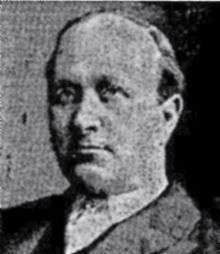
| Party | Candidate | Votes | % | ± | |
|---|---|---|---|---|---|
| Liberal | John Harris | 11,177 | 54.0 | +14.8 | |
| Unionist | Walter Greene | 9,523 | 46.0 | −14.8 | |
| Majority | 1,654 | 8.0 | N/A | ||
| Turnout | 20,700 | 61.2 | −2.3 | ||
| Registered electors | 33,825 | ||||
| Liberal gain from Unionist | Swing | +14.8 | |||
| Party | Candidate | Votes | % | ± | |
|---|---|---|---|---|---|
| Unionist | Austin Hudson | 11,975 | 47.5 | +1.5 | |
| Liberal | John Harris | 7,181 | 28.4 | −25.6 | |
| Labour | Stella Churchill | 6,097 | 24.1 | New | |
| Majority | 4,794 | 19.1 | N/A | ||
| Turnout | 25,253 | 74.2 | +13.0 | ||
| Registered electors | 34,012 | ||||
| Unionist gain from Liberal | Swing | +12.9 | |||
| Party | Candidate | Votes | % | ± | |
|---|---|---|---|---|---|
| Unionist | Austin Hudson | 11,199 | 35.7 | −11.8 | |
| Labour | Frank Bowles | 10,333 | 32.9 | +8.8 | |
| Liberal | John Harris | 9,844 | 31.4 | +3.0 | |
| Majority | 866 | 2.8 | −16.3 | ||
| Turnout | 31,376 | 68.6 | −5.6 | ||
| Registered electors | 45,722 | ||||
| Unionist hold | Swing | −10.3 | |||
Elections in the 1930s
| Party | Candidate | Votes | % | ± | |
|---|---|---|---|---|---|
| Conservative | Austin Hudson | 20,545 | 69.5 | +33.8 | |
| Labour | Frank Bowles | 9,022 | 30.5 | -2.4 | |
| Majority | 11,523 | 38.9 | +36.1 | ||
| Turnout | 29,567 | ||||
| Conservative hold | |||||
| Party | Candidate | Votes | % | ± | |
|---|---|---|---|---|---|
| Conservative | Austin Hudson | 15,000 | 51.9 | -17.6 | |
| Labour | Frank Bowles | 13,920 | 48.1 | +17.6 | |
| Majority | 1,080 | 3.7 | -35.2 | ||
| Turnout | 28,920 | ||||
| Conservative hold | |||||
Elections in the 1940s
| Party | Candidate | Votes | % | ± | ||
|---|---|---|---|---|---|---|
| Labour | Henry Goodrich | 17,337 | 65.0 | +16.9 | ||
| Conservative | Austin Hudson | 5,771 | 21.7 | -30.2 | ||
| Liberal | Doreen Gorsky | 3,546 | 13.3 | New | ||
| Majority | 11,566 | 43.4 | ||||
| Turnout | 26,654 | |||||
| Labour gain from Conservative | ||||||
References
- Representation of the People Act 1867, Schedule C, New Boroughs formed by Division of the Borough of the Tower Hamlets
- Redistribution of Seats Act, 1885, C. 23., Sixth Schedule, Divisions of boroughs. Number, names, contents, and boundaries of divisions.
- Representation of the People Act 1918 c.64, Ninth Schedule: Redistribution of Seats
- Craig, FWS, ed. (1974). British Parliamentary Election Results: 1885-1918. London: Macmillan Press. ISBN 9781349022984.
- "Election Intelligence. North Hackney-Result". The Times. 12 May 1892. p. 6.
- "The General Election. The Polls". The Times. 7 July 1892. p. 6.
- "Progress Of The General Election". The Times. 20 January 1910. p. 6.
- "Progress Of The General Election". The Times. 7 December 1910. p. 7.
- British parliamentary election results, 1918-1949 by FWS Craig
- "The General Election: First Returns, Polling In The Boroughs, Liberal Gains". The Times. 7 December 1923. p. 6.
- "The General Election: First Returns, Polling In The Boroughs". The Times. 30 October 1924. p. 6.
- "The General Election: First Returns, Polling In The Boroughs". The Times. 31 May 1929. p. 6.
- "The General Election: First Returns, Polling In The Boroughs". The Times. 28 October 1931. p. 6.
- "UK general election results 1945". Political Science Resources. University of Keele. Retrieved 2009-04-25.